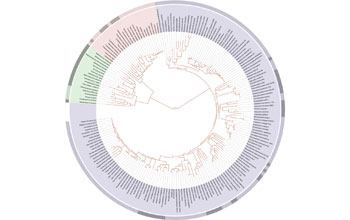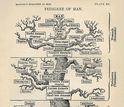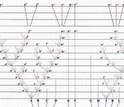News Release 14-124
NSF awards $7.4 million for research on species' evolutionary history
First NSF Genealogy of Life (GoLife) awards will provide new window into evolution of tens of thousands of species, foster synthesis of biodiversity data

Modern-day plot of the "tree of life," based on species' sequenced genomes.
September 17, 2014
This material is available primarily for archival purposes. Telephone numbers or other contact information may be out of date; please see current contact information at media contacts.
As buds give rise by growth to fresh buds, and these, if vigorous, branch out and overtop on all sides many a feebler branch, so by generation I believe it has been with the great Tree of Life, which fills with its dead and broken branches the crust of the earth, and covers the surface with its ever-branching and beautiful ramifications.
--- Charles Darwin, On the Origin of Species by Natural Selection, 1859
The evolution of life on Earth began more than 3.5 billion years ago--and will continue as long as life exists on the planet. The rich tapestry and legacy of evolution has long been depicted by a tree of life. The tree shows the genealogical relationships among myriad living and extinct species.
The term "tree of life" dates to at least the early 1800s. It was first used by Charles Darwin in the concept of a branching-off of species from ancestors.
Twenty years or so later, biologist Ernst Haeckel devised the term phylogeny: the evolutionary relationships of species through time. The modern version of this idea is called a phylogenetic tree.
Over the past decade, progress in gathering and analyzing phylogenetic data has revealed increasingly detailed knowledge of the evolutionary patterns and processes of life on Earth. It has also revealed how much more there is to be learned.
To keep the momentum going, the National Science Foundation (NSF) has awarded $7.4 million in its first Genealogy of Life, or GoLife, grants. The GoLife program is supported by NSF's Directorates for Biological Sciences and for Geosciences.
GoLife builds on major progress made through the previous NSF Assembling the Tree of Life (AToL) program, and leverages recent advances in the collection and analysis of "big data" for reconstructing the evolutionary relationships of species.
The new GoLife program aims to resolve the evolutionary history of all species' lineages (those living, extinct, and poorly known). It also seeks to synthesize as much data as possible, creating a unified knowledge base for comparative research.
GoLife is focused on determining the genealogical patterns for the family tree of all life; enhancing the use of phylogenetic knowledge across biology through the integration of biodiversity data on organisms; and training the next generation of phylogenetic biologists to use that knowledge in new research questions.
"Understanding biodiversity and how it changes over time is best enabled when Earth's diversity is organized into a phylogenetic framework," says Maureen Kearney, GoLife program director in NSF's Division of Environmental Biology.
"All species alive today, and all that have lived on Earth, share at least one thing in common--a phylogenetic history," says Kearney. The Genealogy of Life awards are important for synthesizing knowledge about biodiversity, and for fostering comparative biology and global change research.
A genealogy of life, Kearney says, needs complete data for all clades, or groups of ancestors and their descendants.
"It also requires knowledge of phylogenetic relationships and the process of lineage splitting in deep geologic time," says H. Richard Lane, GoLife program director in NSF's Division of Earth Sciences.
"Most species that ever existed on Earth are now extinct," he says. "Their inclusion in the genealogy of life provides new information on the patterns and processes of diversification throughout the history of life on this changing planet."
The Genealogy of Life awards will advance the understanding of how new species evolve; how extinctions have happened throughout time; how present day species adapt to changing environments; and of biogeographic and ecological patterns and processes.
That knowledge, says Kearney, requires accurate placement of all the tips of the tree of life, and a linking of those results with global data for all species.
NSF's first round of GoLife awards supports studies of: terrestrial (or land-based) vertebrates, including their key traits and geographic distributions assembled phylogenetically; poorly known and ancient groups of fungi, including their symbiotic relationships, genomes, fossil species, and traits; and microbes, using new genomic technology to unravel the evolutionary history of some of the earliest life forms on Earth.
2014 NSF Genealogy of Life Awards (Lead Investigators):
Walter Jetz, Yale University: VertLife Terrestrial: A complete, global assembly of phylogenetic, trait, spatial and environment characteristics for a model clade
Jason Stajich, University of California-Riverside: Collaborative Research: The Zygomycetes Genealogy of Life (ZyGoLife)- the conundrum of Kingdom Fungi
Ramunas Stepanauskas, Bigelow Laboratory for Ocean Sciences: Collaborative research: Untangling the Deep Genealogy of Microbial Dark Matter
-NSF-
-
The tree of life as viewed by Ernst Haeckel in his 1879 work "The Evolution of Man."
Credit and Larger Version -
Tree of life image in Darwin's 1859 book "On the Origin of Species by Natural Selection."
Credit and Larger Version -
An 1847 depiction of the Norse Yggdrasil, or tree of life, from an Icelandic tale.
Credit and Larger Version -
Fold-out paleontological chart by Edward Hitchcock in his 1840 work "Elementary Geology."
Credit and Larger Version -
A 17th-century painting of the tree of life in the Palace of Shaki Khans in Azerbaijan.
Credit and Larger Version
Media Contacts
Cheryl Dybas, NSF, (703) 292-7734, email: cdybas@nsf.gov
The U.S. National Science Foundation propels the nation forward by advancing fundamental research in all fields of science and engineering. NSF supports research and people by providing facilities, instruments and funding to support their ingenuity and sustain the U.S. as a global leader in research and innovation. With a fiscal year 2023 budget of $9.5 billion, NSF funds reach all 50 states through grants to nearly 2,000 colleges, universities and institutions. Each year, NSF receives more than 40,000 competitive proposals and makes about 11,000 new awards. Those awards include support for cooperative research with industry, Arctic and Antarctic research and operations, and U.S. participation in international scientific efforts.
Connect with us online
NSF website: nsf.gov
NSF News: nsf.gov/news
For News Media: nsf.gov/news/newsroom
Statistics: nsf.gov/statistics/
Awards database: nsf.gov/awardsearch/
Follow us on social
Twitter: twitter.com/NSF
Facebook: facebook.com/US.NSF
Instagram: instagram.com/nsfgov





